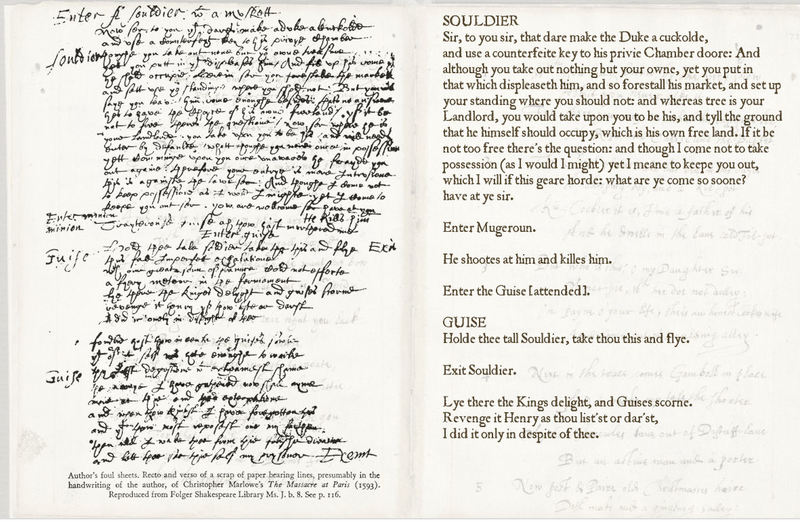John Donne's Manuscript of Poems Transposed to Digital Media
The Houghton Library houses a collection of rare books and manuscripts, with texts ranging from early to modern periods of history. One of the texts that can be found at the Houghton Library is a manuscript of John Donne’s poems. John Donne, an English poet, produced much of his work during the early seventeenth century. This handwritten text was completed on October 12, 1632, as written on the title page of the manuscript (see image). The text has also been preserved in Harvard’s digitized collection online, where users can easily view images of each page of the manuscript from remote locations. In the format of an electronic book, or e-book, Donne’s manuscript is now accessible to a much larger audience.
Since gaining popularity in the early 2000s, e-books and e-book readers have been in common use. They can be spotted alongside paperbacks in bookstores and in the hands of young and old readers alike. The first e-book reader was released in 1998, and the now common Kindle e-reader entered the market in 2007. This new technology has provided readers with the ability to access millions of books right at their fingertips.
With the introduction of e-books and e-readers, digital media has changed the way people consume texts. According to this blog entry, new words have even emerged in association with “e-reading.” Rather than turning the pages of a traditional book, readers can manipulate the pages of an e-book with a tap, swipe, pinch, or scroll. These words have certainly taken on a different meaning since the seventeenth century, when Donne’s manuscript was written.
Harvard’s digitized version of the manuscript provides readers with the entire visual experience of the text. There are no visible differences between the images and the physical copy of the manuscript. The images of the manuscript have even captured the worn spine and the frayed edges of the cover. The e-book version further enhances the reader’s experience of the text with functions that allow the reader to zoom in and examine Donne’s script more closely. This could give readers the chance to notice subtle details that they might have otherwise missed. Another benefit that the digital e-book offers is preventing the deterioration of the physical manuscript. If more readers choose to view the e-book, the manuscript would be handled less often and its conditions would be preserved.
Still, the experience of clicking through the pages of an e-book lacks the gravity of cautiously handling a rare manuscript. There is no longer a need to consider the fragile conditions of the aged text. Without the physical weight of the manuscript and the texture of thin pages between your fingers, it can be difficult to appreciate the inherent value of the object. The experience and wonder of handling a historically important text and being surrounded by such valuable books cannot be reproduced by an e-book.
Although users can view the manuscript online, many may still struggle with actually reading or understanding the handwritten text. The script that Donne used, Secretary Hand, was common among nobles and clergymen in England during the early modern period. Secretary hand is characterized by its flourishes, loops, and joined letters, much like cursive scripts. However, certain letters have a different appearance than modern day letters and secretary hand used a unique abbreviation system of writing that would be difficult to understand today. For readers in the twenty-first century, the script might have a stronger resemblance to an indecipherable code rather than familiar English script.
To make Donne’s manuscript even more accessible to readers, the handwritten manuscript could be transposed to typeface. A comparison of typeface and the secretary hand emphasizes the increased readability of typeface. It would be much easier to comprehend Donne’s poems in typeface, which might shift a reader’s focus to a close reading of the text rather than a close examination of the script to understand its meaning. Alternatively, a typeface version of the manuscript would allow readers to quickly skim the text to gain a brief overview.
With such a transposition, the cultural and historic importance of the manuscript might be lost. Preserving the digital image of the manuscript maintains its cultural importance, as readers are still able to appreciate the text in its original form. Even as an e-book, the secretary hand and Donne’s personalization of the text has been preserved. A typeface e-book would transform the text into a modern product that lacks a strong connection to the manuscript’s historical context. Instead, readers might hold the typeface e-book in similar regard as other books of modern poetry. While this might garner more attention for the manuscript and make it more attractive to the modern day audience, the typeface e-book would not hold the same cultural significance as the digital e-book images or the physical manuscript itself. The introduction of e-books and e-readers presents novel experiences for readers, but none of these can replace the experience of handling a rare manuscript.


